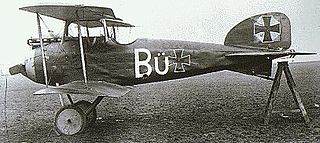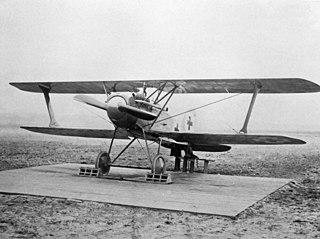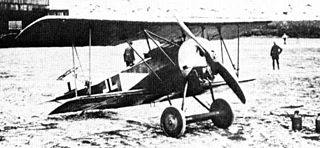Related Research Articles

The Fokker E.V was a German parasol-monoplane fighter aircraft designed by Reinhold Platz and built by Fokker-Flugzeugwerke. The E.V was the last Fokker design to become operational with the Luftstreitkräfte, entering service in the last months of World War I. After several fatal accidents due to wing failures, the aircraft was modified and redesignated Fokker D.VIII. Dubbed the Flying Razor by Allied pilots, the D.VIII had the distinction of scoring the last aerial victory of the war.

The AEG PE was a triplane ground-attack aircraft of World War I, one of the first aircraft designed from the outset for that role. The Idflieg rejected it on the grounds that its poor maneuverability made it too vulnerable to enemy fighters.

The Albatros D.I was a German fighter aircraft used during World War I. Although its operational career was short, it was the first of the Albatros D types which equipped the bulk of the German and Austrian fighter squadrons (Jagdstaffeln) for the last two years of the war.

The Albatros D.IV was an experimental German fighter aircraft built and tested during World War I.

The Fokker D.I was a development of the D.II fighter. The D.I was also flown in Austro-Hungarian service as a fighter trainer aircraft under the designation B.III. Confusing the matter further, both the D.II and D.I arrived at the Front in German service at similar times, in July–August 1916. The main designer was Martin Kreutzer.

The Albatros D.X was a German prototype single-seat fighter biplane developed in 1918 in parallel with the Albatros D.IX.

The Albatros D.XII was a German single-seat fighter biplane first flown in March 1918. It was the last of the Albatros fighters completed and flown before the end of World War I and had the same slab-sided fuselage seen on the Albatros D.X.

The AGO C.VIII was a German reconnaissance aircraft built by AGO Flugzeugwerke during World War I.

The LFG Roland C.II, usually known as the Walfisch (Whale), was an advanced German reconnaissance aircraft of World War I. It was manufactured by Luft-Fahrzeug-Gesellschaft G.m.b.H.

The Hannover CL.III was a German military aircraft of World War I. It was a two-seat multi-role aircraft, primarily used as a ground attack machine. Like the other Hannover "light-C-class", or "CL" designated aircraft designed by Hermann Dorner, it included an unusual biplane tail, allowing for a greater firing arc for the tail gunner. Until the introduction of the aircraft, such tails had only been used on larger aircraft.

The Pfalz D.VIII was a German World War I fighter aircraft.

The Fokker D.VI was a German fighter aircraft built in limited numbers at the end of World War I. The D.VI served in the German and Austro-Hungarian air services.

The Fokker M 10 was a two-seater reconnaissance / fighter-trainer biplane with single-bay wings equipped with wing-warping controls for roll, powered by a 7-cylinder 80 hp Oberursel U.0 engine. Several M 10 aircraft were purchased by the Imperial and Royal Aviation Troops of Austro Hungary.
The Euler D.II was a German single-seat fighter, the successor to the earlier Euler D.I. The D.II was essentially a re-engined Euler D.I, the air-frame being virtually unchanged and the power plant being a 100 hp Oberusel U I 9-cylinder rotary.

The Pfalz Dr.I was a German fighter prototype of World War I. Official interest in the potential of the triplane configuration for single-seat fighters prompted Pfalz to develop the Dr.I. It underwent initial testing in October 1917, and an initial batch of 10 aircraft were shipped to the Front and arrived in April 1918.

The LFG Roland D.XVI, initially designated the LFG Roland E.I, was a single-seat, single-engine, parasol wing German fighter aircraft flown close to the end of World War I. Only two were built.
The Daimler D.IIIb was a V-8, water-cooled, piston engine developed in Germany by Daimler Motoren Gesellschaft, for use in aircraft in 1918.
The Halberstadt B-types of the Halberstädter Flugzeugwerke were two-seat unarmed reconnaissance/training aircraft of the German Air Force in the First World War.
The LVG D.II was a German fighter plane built by LVG in World War I. It originally flew in 1916, but was damaged during flight tests and never saw production.

The Gotha LD 5 was a military aircraft produced in Germany during the early part of World War I.
References
- Gray, Peter & Thetford, Owen. German Aircraft of the First World War. London, Putnam. (2nd Ed.) 1970. ISBN 0-370-00103-6